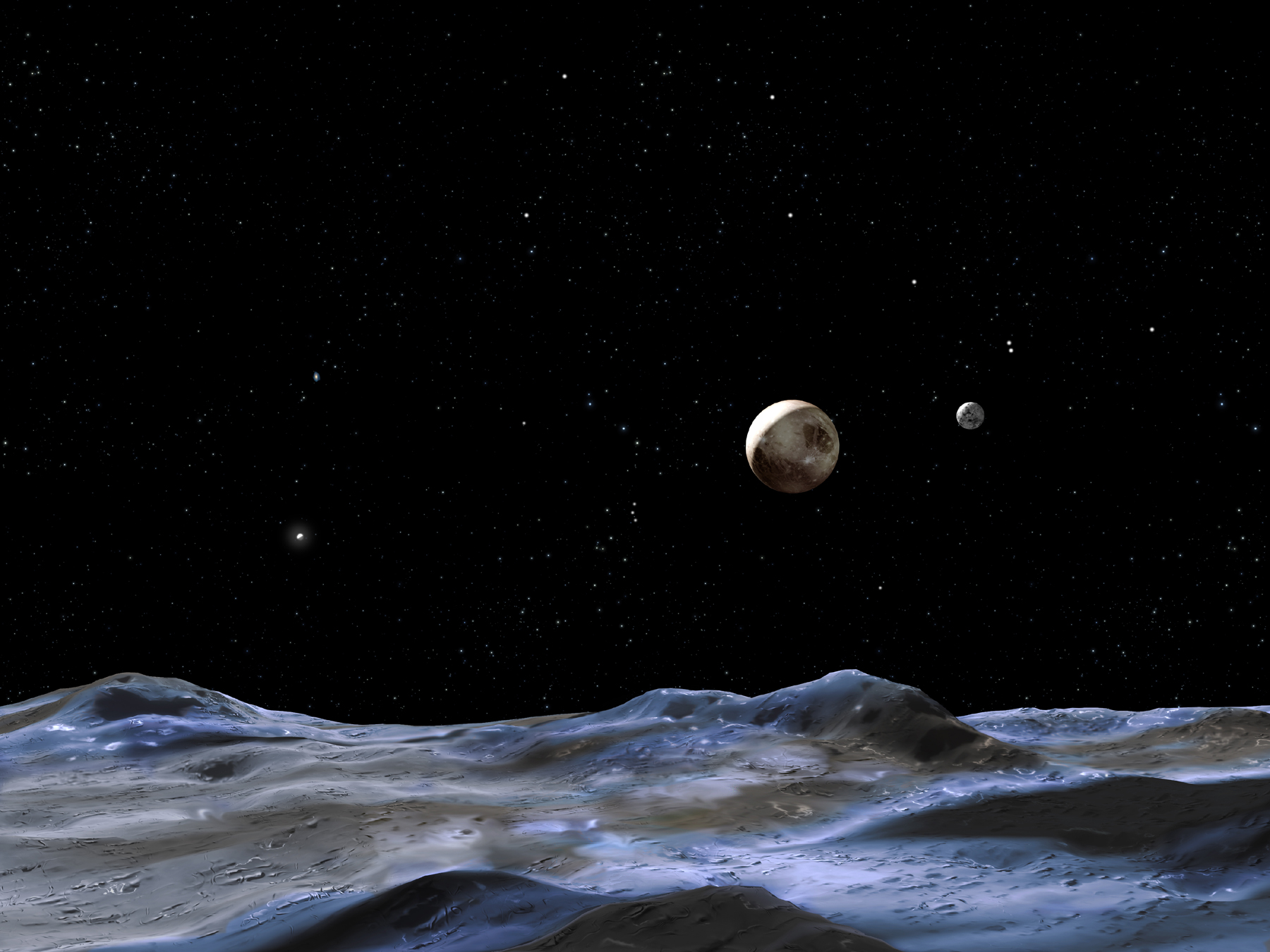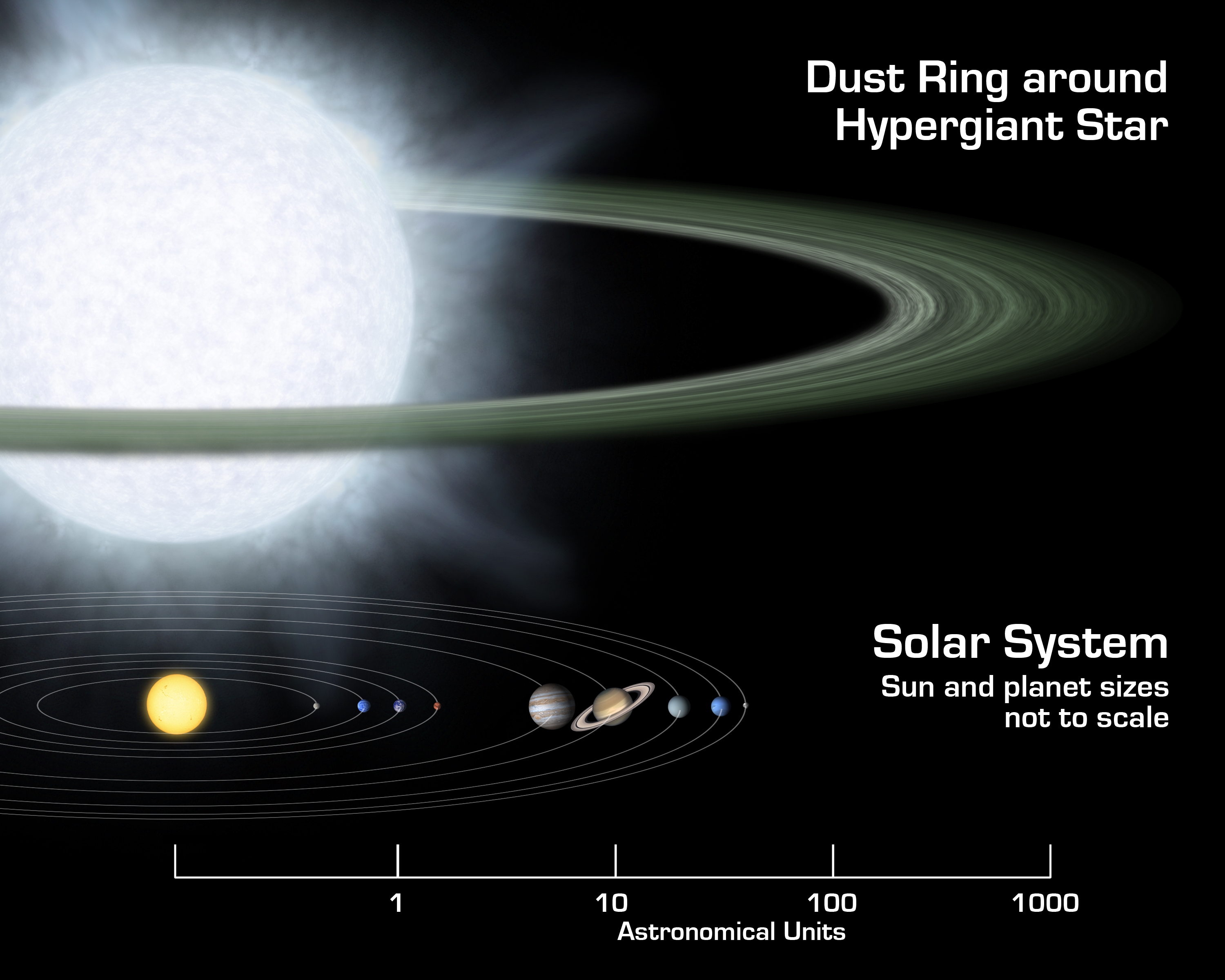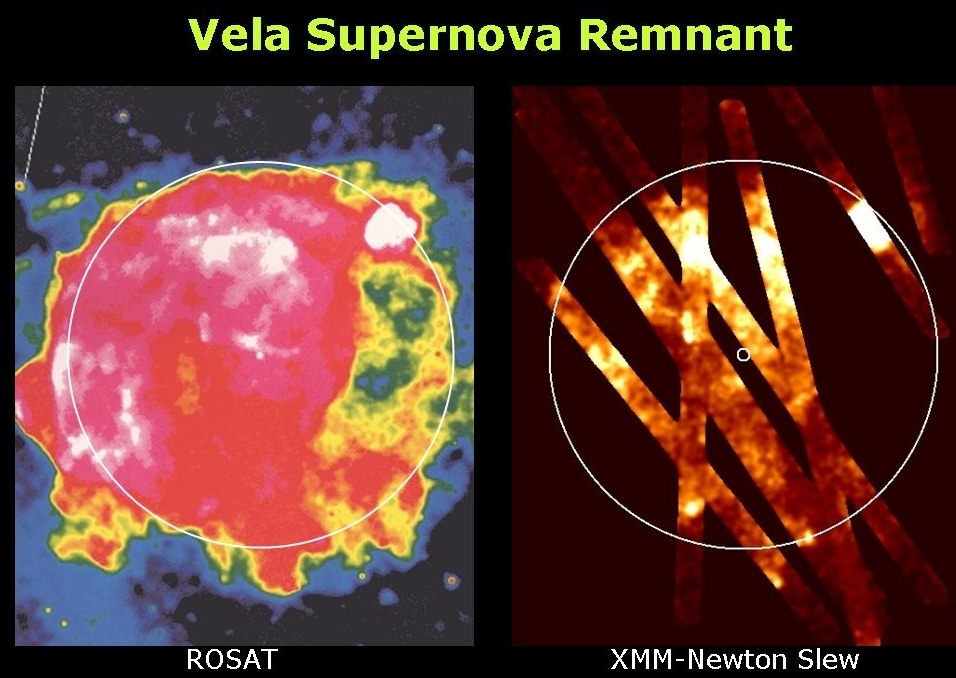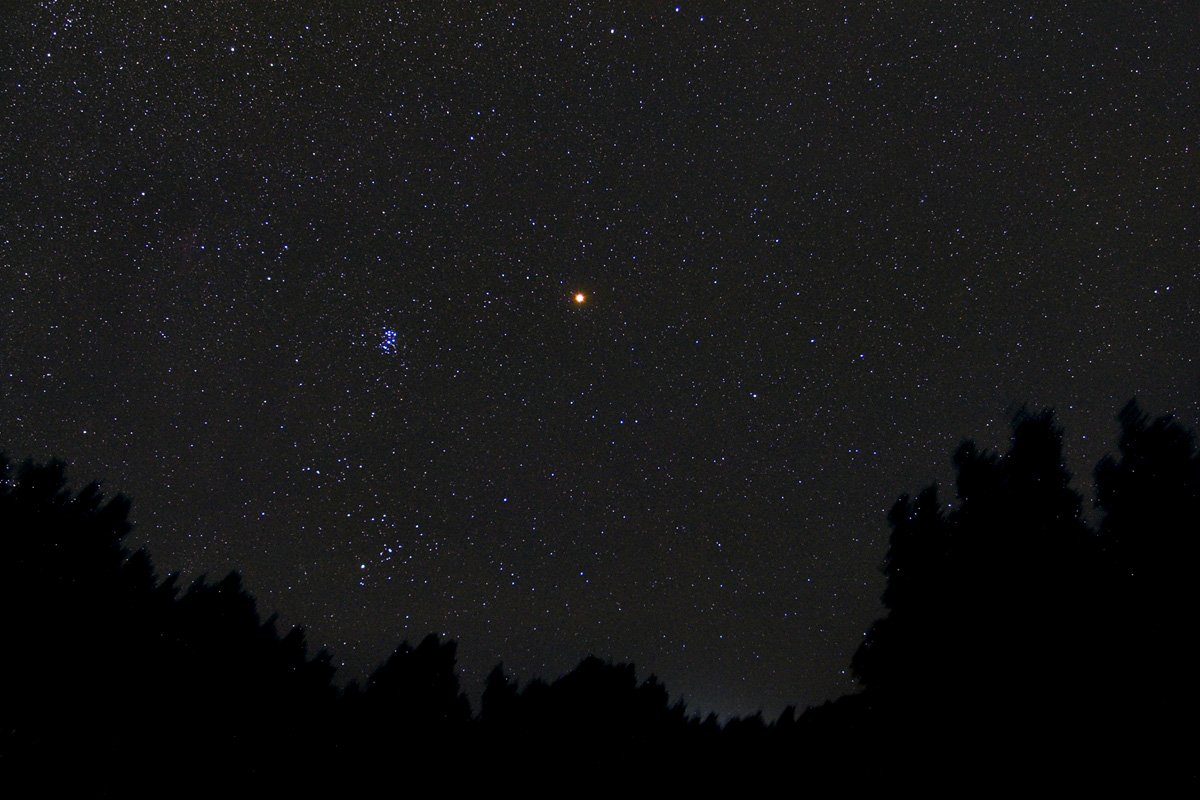Next Launch
Total Students
2,609
Total Launches
683
Eggs Survived
418 61.2%
Rockets Survived
536 78.5%
Feb. 1, 2006
Snowstorm on Pluto
by Dr. Tony Phillips
There's a nip in the air. Outside it's beginning to snow, the first fall of winter. A few delicate flakes tumble from the sky, innocently enough, but this is no mere flurry.
Soon the air is choked with snow, falling so fast and hard it seems to pull the sky down with it. Indeed, that's what happens. Weeks later when the storm finally ends the entire atmosphere is gone. Every molecule of air on your planet has frozen and fallen to the ground.
That was a snowstorm--on Pluto.
Once every year on Pluto (1 Pluto-year = 248 Earth-years), around the beginning of winter, it gets so cold that the atmosphere freezes. Air on Pluto is made mainly of nitrogen with a smattering of methane and other compounds. When the temperature dips to about 32 K (-240 C), these molecules crystallize and the atmosphere comes down.
"The collapse can happen quite suddenly," says Alan Stern of the Southwest Research Institute. "Snow begins to fall, the surface reflects more sunlight, forcing quicker cooling, accelerating the snowfall. It can all be over in a few weeks or months."
Researchers believe this will happen sometime during the next 10 to 20 years. Pluto is receding from the warmth of the Sun, carried outward by its 25% elliptical orbit. Winter is coming.
So is New Horizons. Stern is lead scientist for the robotic probe, which left Earth in January bound for Pluto. In 2015 New Horizons will become the first spacecraft to visit that distant planet. The question is, will it arrive before the snowstorm?
"We hope so," says Stern. The spacecraft is bristling with instruments designed to study Pluto's atmosphere and surface. "But we can't study the atmosphere if it's not there." Furthermore, a layer of snow on the ground ("probably a few centimeters deep," estimates Stern) could hide the underlying surface from New Horizon's remote sensors.
Stern isn't too concerned: "Pluto's atmosphere was discovered in 1988 when astronomers watched the planet pass in front of a distant star--a stellar occultation." The star, instead of vanishing abruptly at Pluto's solid edge, faded slowly. Pluto was "fuzzy;" it had air. "Similar occultations observed since then (most recently in 2002) reveal no sign of [impending] collapse," says Stern. On the contrary, the atmosphere appears to be expanding, puffed up by lingering heat from Pluto's waning summer.
Nevertheless, it's a good thing New Horizons is fast, hurtling toward Pluto at 30,000 mph. Winter. New Horizons. Only one can be first. The race is on….
Find out more about the New Horizons mission at http://pluto.jhuapl.edu. Kids can learn amazing facts about Pluto at spaceplace.nasa.gov/en/kids/pluto.
This article was provided by the Jet Propulsion Laboratory, California Institute of Technology, under a contract with the National Aeronautics and Space Administration.
 This artist’s rendering shows how Pluto and two of its possible three moons might look from the surface of the third moon. Credit: NASA/ESA and G. Bacon (STSci)
This artist’s rendering shows how Pluto and two of its possible three moons might look from the surface of the third moon. Credit: NASA/ESA and G. Bacon (STSci)
March 1, 2006
Planets in Strange Places
by Trudy E. Bell
Red star, blue star, big star, small star—planets may form around virtually any type or size of star throughout the universe, not just around mid-sized middle-aged yellow stars like the Sun. That’s the surprising implication of two recent discoveries from the 0.85-meter-diameter Spitzer Space Telescope, which is exploring the universe from orbit at infrared (heat) wavelengths blocked by the Earth’s atmosphere.
At one extreme are two blazing, blue “hypergiant” stars 180,000 light-years away in the Large Magellanic Cloud, one of the two companion galaxies to our Milky Way. The stars, called R 66 and R 126, are respectively 30 and 70 times the mass of the Sun, “about as massive as stars can get,” said Joel Kastner, professor of imaging science at the Rochester Institute of Technology in New York. R 126 is so luminous that if it were placed 10 parsecs (32.6 light-years) away—a distance at which the Sun would be one of the dimmest stars visible in the sky—the hypergiant would be as bright as the full moon, “definitely a daytime object,” Kastner remarked.
Such hot stars have fierce solar winds, so Kastner and his team are mystified why any dust in the neighborhood hasn’t long since been blown away. But there it is: an unmistakable spectral signature that both hypergiants are surrounded by mammoth disks of what might be planet-forming dust and even sand.
At the other extreme is a tiny brown dwarf star called Cha 110913-773444, relatively nearby (500 light-years) in the Milky Way. One of the smallest brown dwarfs known, it has less than 1 percent the mass of the Sun. It’s not even massive enough to kindle thermonuclear reactions for fusing hydrogen into helium. Yet this miniature “failed star,” as brown dwarfs are often called, is also surrounded by a flat disk of dust that may eventually clump into planets. (Note: This brown dwarf discovery was made by a group led by Kevin Luhman of Pennsylvania State University.)
Although actual planets have not been detected (in part because of the stars’ great distances), the spectra of the hypergiants show that their dust is composed of forsterite, olivine, aromatic hydrocarbons, and other geological substances found on Earth.
These newfound disks represent “extremes of the environments in which planets might form,” Kastner said. “Not what you’d expect if you think our solar system is the rule.”
Hypergiants and dwarfs? The Milky Way could be crowded with worlds circling every kind of star imaginable—very strange, indeed.
Keep up with the latest findings from the Spitzer at http://www.spitzer.caltech.edu/ . For kids, the Infrared Photo Album at The Space Place http://spaceplace.nasa.gov/en/kids/sirtf1/sirtf_action.shtml) introduces the electromagnetic spectrum and compares the appearance of common scenes in visible versus infrared light.
This article was provided by the Jet Propulsion Laboratory, California Institute of Technology, under a contract with the National Aeronautics and Space Administration.
 Artist’s rendering compares size of a hypothetical hypergiant star and its surrounding dusty disk to that of our solar system.
Artist’s rendering compares size of a hypothetical hypergiant star and its surrounding dusty disk to that of our solar system.
May 1, 2006
Not a Moment Wasted
by Dr. Tony Phillips
The Ring Nebula. Check. M13. Check. Next up: The Whirlpool galaxy.
You punch in the coordinates and your telescope takes off, slewing across the sky. You tap your feet and stare at the stars. These Messier marathons would go much faster if the telescope didn’t take so long to slew. What a waste of time!
Don’t tell that to the x-ray astronomers.
“We’re putting our slew time to good use,” explains Norbert Schartel, project scientist for the European Space Agency’s XMM-Newton x-ray telescope. The telescope, named for Sir Isaac Newton, was launched into Earth orbit in 1999. It’s now midway through an 11-year mission to study black holes, neutron stars, active galaxies and other violent denizens of the Universe that show up particularly well at x-ray wavelengths.
For the past four years, whenever XMM-Newton slewed from one object to another, astronomers kept the telescope’s cameras running, recording whatever might drift through the field of view. The result is a stunning survey of the heavens covering 15% of the entire sky.
Sifting through the data, ESA astronomers have found entire clusters of galaxies unknown before anyone started paying attention to “slew time.” Some already-known galaxies have been caught in the act of flaring—a sign, researchers believe, of a central black hole gobbling matter from nearby stars and interstellar clouds. Here in our own galaxy, the 20,000 year old Vela supernova remnant has been expanding. XMM-Newton has slewed across it many times, tracing its changing contours in exquisite detail.
The slew technique works because of XMM-Newton’s great sensitivity. It has more collecting area than any other x-ray telescope in the history of astronomy. Sources flit through the field of view in only 10 seconds, but that’s plenty of time in most cases to gather valuable data.
The work is just beginning. Astronomers plan to continue the slew survey, eventually mapping as much as 80% of the entire sky. No one knows how many new clusters will be found or how many black holes might be caught gobbling their neighbors. One thing’s for sure: “There will be new discoveries,” says Schartel.
Tap, tap, tap. The next time you’re in the backyard with your telescope, and it takes off for the Whirlpool galaxy, don’t just stand there. Try to keep up with the moving eyepiece. Look, you never know what might drift by.
See some of the other XMM-Newton images at http://sci.esa.int. For more about XMM-Newton’s Education and Public Outreach program, including downloadable classroom materials, go to http://xmm.sonoma.edu. Kids can learn about black holes and play “Black Hole Rescue” at The Space Place, http://spaceplace.nasa.gov/, under “Games.”
This article was provided by the Jet Propulsion Laboratory, California Institute of Technology, under a contract with the National Aeronautics and Space Administration.
 The image on the left is the Vela Supernova Remnant as imaged in X-rays by ROSAT. On the right are some of the slew images obtained by XMM-Newton in its “spare” time.
The image on the left is the Vela Supernova Remnant as imaged in X-rays by ROSAT. On the right are some of the slew images obtained by XMM-Newton in its “spare” time.
Oct. 1, 2006
Halloween is a big night for astronomers
by Dr. Tony Phillips
According to the National Retail Foundation, the most popular Halloween costume last year was Spiderman. Next was "a princess," followed by witches and vampires, SpongeBob, Barbie and Harry Potter.
Sounds about right. But if you read the complete list of top costumes, you'll notice something missing: astronomers. There are no Sagans, no Galileos, not even a Hubble.
And that's funny, because Halloween is an astronomical holiday.
It has to do with seasons: Halloween is a "cross-quarter date,"[More] approximately midway between an equinox and a solstice. There are four cross-quarter dates throughout the year, and each is a minor holiday: Groundhog Day (Feb. 2nd), May Day (May 1st), Lammas Day (Aug. 1st), and Halloween (Oct. 31st).
Long ago, "the Celts of the British Isles used cross-quarter days to mark the beginnings of seasons," says John Mosley of the Griffith Observatory in Los Angeles. "Winter began with Halloween, [or as they called it, 'Samhain']. Halloween marked the transition between summer and winter, light and dark -- and life and death."
"On that one night, according to folklore, those who had died during the previous year returned for a final visit to their former homes. People set out food and lit fires to aid them on their journey -- but remained on guard for mischief the spirits might do."
And, so, something astronomical became something spooky. It's not the first time. Have you heard that comets are bad omens? Or that a full moon brings out werewolves? Astronomy and superstition are old friends.
This year Halloween has a new astronomical significance:
On Oct. 31st, the planet Mars is making its closest approach to Earth for the next 13 years. (13 years? Cross your fingers.) Technically speaking, the moment of closest approach occurs on Oct. 30th, a day before Halloween, but the difference in distance between the 30th and the 31st is too slight to matter.
Trick or Treaters will notice Mars rising in the east at sunset: sky map. It looks like a pumpkin-colored star, so intense that people in brightly-lit cities can see it. Some say it's blood red, but maybe that's just Halloween talking.
Mars will soar almost overhead at midnight (as seen from North America) and stay "up" all night long. Halloween 2005 is truly the night of Mars.

Above: Mars rising over Payson Arizona on Oct. 25, 2005. Credit: Chris Shur.
Because Mars is so close--only 69 million km away, which is close on the vast scale of the solar system--it looks great through a backyard telescope. Lately amateur astronomers have been watching dust storms swirl around Mars. They've seen icy-blue clouds gather over the Martian north pole, where it is winter. And they been sketching and photographing strange dark markings that dapple the planet's surface.
So--nothing against Spiderman, mind you--you might wish to reconsider your costume. Grab a telescope and be an astronomer. It is Halloween, after all.
This article was provided by the Jet Propulsion Laboratory, California Institute of Technology, under a contract with the National Aeronautics and Space Administration.
 Red crosses mark the year's cross-quarter dates.
Red crosses mark the year's cross-quarter dates.